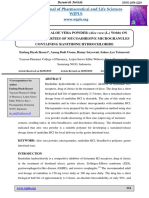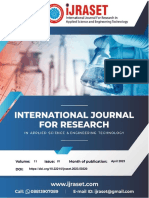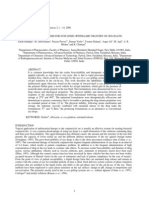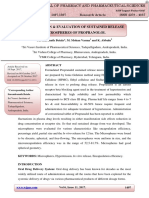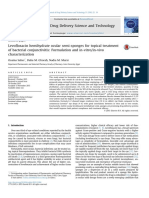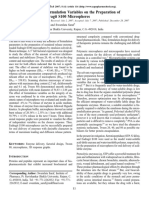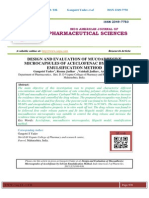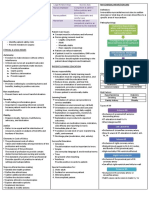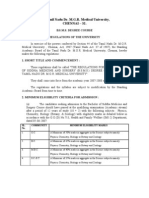Formulation and Evaluation of Deflazacort Loaded M
Formulation and Evaluation of Deflazacort Loaded M
Uploaded by
Adetya MaryaniCopyright:
Available Formats
Formulation and Evaluation of Deflazacort Loaded M
Formulation and Evaluation of Deflazacort Loaded M
Uploaded by
Adetya MaryaniOriginal Title
Copyright
Available Formats
Share this document
Did you find this document useful?
Is this content inappropriate?
Copyright:
Available Formats
Formulation and Evaluation of Deflazacort Loaded M
Formulation and Evaluation of Deflazacort Loaded M
Uploaded by
Adetya MaryaniCopyright:
Available Formats
Purohit et al Journal of Drug Delivery & Therapeutics.
2019; 9(1):79-84
Available online on 15.01.2019 at http://jddtonline.info
Journal of Drug Delivery and Therapeutics
Open Access to Pharmaceutical and Medical Research
© 2011-18, publisher and licensee JDDT, This is an Open Access article which permits unrestricted
non-commercial use, provided the original work is properly cited
Open Access Research Article
Formulation and evaluation of deflazacort loaded mucoadhesive
microsphere for colon drug delivery system
Akash Purohit*, Mithun Bhowmick, Jagdish Rathi
NRI Institute of Pharmaceutical Sciences, Bhopal (M.P), India
ABSTRACT
Irritable bowel disease is very common colon disease. Deflazacort is one of the best drug with clinical activity against Irritable bowel disease.
Microsphere system are effectively protect drugs against premature degradation, to localize drug molecules at the target site of action and to
control the time and rate of release. Mucoadhesive microspheres enhance the bioavailability of orally given drugs by lengthened contact time of
drug with the intestinal mucosa. The main disadvantage of these microspheres is adherence to the substrate by non-specific interaction. To
overcome this limitation, microspheres are prepared by emulsification method to treat irritable bowel disease. Chitosan microspheres were
prepared by Ionotropic Gelation method. Microspheres were coated with Eudragil S using solvent evaporation method.
Keywords: Deflazacort, Mucoadhesive, Microspheres, Irritable bowel disease
Article Info: Received 02 Sep 2018; Review Completed 29 Sep 2018; Accepted 18 Dec 2018; Available online 15 Jan 2019
Cite this article as:
Purohit A, Bhowmick M, Rathi J, Formulation and evaluation of deflazacort loaded mucoadhesive microsphere for colon
drug delivery system, Journal of Drug Delivery and Therapeutics. 2019; 9(1):79-84
DOI: http://dx.doi.org/10.22270/jddt.v9i1.2164
*Address for Correspondence:
Akash Purohit, NRI Institute of Pharmaceutical Sciences, Bhopal (M.P), India
INTRODUCTION mucoadhesive properties may prolong the residence time at
the site of drug absorption.3-4
Colon was considered as a part of body solely responsible for
absorption of water, electrolyte and temporary storage of MATERIAL AND METHODS
stools, but now it is accepted as an important site for drug
Material
delivery. Targeted delivery ensures the direct treatment at
the disease site, lower dosing, and minimizing side effects. Deflazacort was collected as a gift sample from Alcon bio
Drug targeting to colon is highly desirable for local treatment sciences PVT Ltd, Mumbai. Eudragit-S 100 obtained from
of a variety of bowel diseases. Moreover, dosage forms with Degussa India Pvt Ltd. Sodium Alginate and chitosan were
mucoadhesive properties may prolong the residence time at received from Loba Chemie Pvt. Ltd (Mumbai, India). All
the site of drug absorption. Mucoadhesive microparticulates other reagents and chemicals used were of analytical grade.
coated with a pH-dependent polymer are proposed to
initiate the release of the drug at the putative colonic pH 7– Methods
8.1-3 Deflazacort is a drug of choice in Ulcerative colitis with Preparation of mucoadhesive microsphere of
proven anti inflammatory and immunosuppressive effect. Deflazacort
Deflazacort is a corticosteroid that works by acting within
cells to prevent the release of certain chemicals that are Chitosan microspheres were prepared by ionotropic gelation
important in the immune system. These chemicals are method.
involved in producing immune and allergic responses, Preparation I: Chitosan stock solution (1% w/v) was
resulting in inflammation by decreasing the release of these prepared by dissolving chitosan in acetic acid (1% v/v) at
chemicals in a particular area, inflammation is reduced. room temperature.
Deflazacort has a shorter biological half life of 1.1-1.9 hr.
Thus by using deflazacort microspheres half life is increased Preparation II: The drug and sodium alginate was dissolved
and provide sustained release of drug for longer duration in 100 ml of water.
and thus bioavailability problems associated with oral
Preparation III: 1% Sodium tripolyphosphate solution was
administration is also improved and microspheres with
prepared.
ISSN: 2250-1177 [79] CODEN (USA): JDDTAO
Purohit et al Journal of Drug Delivery & Therapeutics. 2019; 9(1):79-84
Preparation IV: Solution of preparation I was slowly added dropping rate and falling distance were kept constant. The
in preparation III with continuous starring on magnetic solution was magnetically stirred for half an hour followed
stirrer. by filtration and rinsing with distilled water. Gel like beads
were obtained which was air dried for twenty four hours
Preparation II was added in preparation IV through a
followed by oven drying for six hours at 40˚C. 5-6
disposable syringe needle into a gently agitating. The
Table 1: Formulations of the mucoadhasive microspheres
Chitosan Sod. Alginate
Sr. No Formulation Code Deflazacort (mg)
(mg) (mg)
1. F1 10 25 50
2. F2 10 25 75
3. F3 10 25 100
4. F4 10 50 50
5. F5 10 50 75
6. F6 10 50 100
Coating of mucoadhasive microspheres microspheres still adhering to the tissue was counted. The
test was performed at 0.1N hydrochloric acid solution.
Microspheres were coated with Eudragil S (ES) using solvent
evaporation method. mucoadhasive microspheres (50 mg) % Mucoadhesion = (Na-Nl) / Na × 100
were dispersed in 10 mL of coating solution prepared by
Where, Na = number of microspheres applied; Nl = number
dissolution of 500 mg of ES in ethanol:acetone (2:1) to give
of microspheres leached out.9-10
5:1 (coat:core ratio). This organic phase was then poured in
70 mL of light liquid paraffin containing 1% wt/vol Span 80. Measurement of mean particle size
The system was maintained under agitation speed of 1000
rpm at room temperature for 3 hours to allow for the The mean size of the microspheres was determined by Photo
evaporation of solvent. Finally, the coated microsphere were Correlation Spectroscopy (PCS) on a submicron particle size
filtered, washed with n-hexane, and dried in desiccator.7-8 analyzer at a scattering angle of 90°. A sample (0.5mg) of the
microspheres suspended in 5 ml of distilled water was used
Evaluation of microspheres for the measurement. 11
Percentage Yield Determination of zeta potential
The prepared microspheres with a size range of 200-300nm The zeta potential of the drug-loaded microspheres was
were collected and weighed from different formulations. The measured on a zeta sizer by determining the electrophoretic
measured weight was divided by the total amount of all non- mobility in a micro electrophoresis flow cell. All the samples
volatile components which were used for the preparation of were measured in water at 25°C in triplicate.9-11
the microspheres.5-6
Shape and Surface Characterization of Microspheres by
Scanning Electron Microscopy (SEM)
From the formulated batches of microspheres, formulations
Drug Entrapment (F3) which showed an appropriate balance between the
percentage releases were examined for surface morphology
The various formulations of the mucoadhasive microspheres
and shape using scanning electron microscope Jeol Japan
were subjected for drug content. 10 mg of mucoadhasive
6000. Sample was fixed on carbon tape and fine gold
microspheres from all batches were accurately weighed and
sputtering was applied in a high vacuum evaporator. The
crushed. The powder of microspheres were dissolved in 10
acceleration voltage was set at 10KV during scanning.
ml 7.4 pH Phosphate Buffer and centrifuge at 1000 rpm. This
Microphotographs were taken on different magnification and
supernatant solution is than filtered through whatmann
higher magnification (200X) was used for surface
filter paper No. 44. After filtration, from this solution 0.1 ml
morphology.10-12
was taken out and diluted up to 10 ml with 7.4 pH Phosphate
Buffer. The percentage drug entrapment was calculated In-vitro Release Studies
using calibration curve method.7-8
In vitro drug release in gastrointestinal fluids of
In-vitro wash off test different pH
The mucoadhesive property of microspheres was evaluated The prepared microsphere was evaluated for in vitro drug
by an in vitro adhesion testing method known as the wash- release. The drug release studies were carried out using USP
off test. Freshly excised pieces of intestinal mucosa from XXII paddle type Dissolution test apparatus. The dissolution
sheep were mounted onto glass slide. About 100 study was carried out in 900 ml dissolution medium which
microspheres were spread onto wet rinsed tissue specimen was stirred at 100 rpm maintained at 37±0.2C. The scheme
and immediately thereafter the slides were hung onto the of using the simulated fluids at different timing was as
arm of a tablet disintegrating machine. Then the machine follows:
was operated. The tissue specimen was given a slow, regular
up and down movement in the test fluid at about 37°C 1st hour: Simulated gastric fluid (SGF) of pH 1.2.
contained in a vessel of the machine. At the end of 1, 2, 3, 4, 5,
6, 7,8 hrs the machine was stopped and the number of 2nd and 3rd hour: Mixture of simulated gastric and
Intestinal fluid of pH 4.5.
ISSN: 2250-1177 [80] CODEN (USA): JDDTAO
Purohit et al Journal of Drug Delivery & Therapeutics. 2019; 9(1):79-84
4th to 5th hour: Simulated intestinal fluid (SIF) of pH 6.8. Figure 1: Percentage Yield for different formulation
Drug Entrapment
6th hour and onward: SIF pH 7.5
The drug entrapment of different formulations was in range
A weighed quantity of formulation (100 mg) was spread over of 78.05- 83.25% w/w. This is due to the permeation
the surface of dissolution media (900 ml) at 37±0.2C. characteristics of HPMC that could facilitate the diffusion of
Samples were withdrawn at different time interval and part of entrapped drug to surrounding medium during
compensated with same amount of fresh dissolution preparation of deflazacort microspheres.
medium. Volume of sample withdrawn was made up to 10ml
by continuous media. The samples withdrawn were assayed Table 3: Drug Entrapment for Different Formulation
spectrophotometrically at 242.0 nm for deflazacort and
Drug entrapment (% w/w)
using UV visible spectrophotometer. The release of Formulation of prepared microsphere
deflazacort was calculated with the help of Standard curve of
deflazacort.9-12 F1 78.05±0.25
F2 79.98±0.32
Drug release kinetic data analysis F3 82.56±0.14
Several kinetic models have been proposed to describe the F4 80.12±0.57
release characteristics of a drug from matrix. The following F5 81.14±0.54
three equations are commonly used, because of their F6 83.25±0.45
simplicity and applicability. Equation 1, the zero-order
model equation (Plotted as cumulative percentage of drug
released vs time); Equation 2, Higuchi’s square-root equation
(Plotted as cumulative percentage of drug released vs square
root of time); and Equation 3, the Korsemeyer-Peppas
equation (Plotted as Log cumulative percentage of drug
released vs Log time).10-12
RESULTS AND DISCUSSION
Evaluation of deflazacort microspheres
Percentage Yield
Percentage yield of different formulation was determined by
weighing the Microspheres after drying. The percentage
yield of different formulation was in range of 82.56 –
93.58%.
Table 2: Percentage Yield for Different Formulation
Formulation Percentage Yield
Figure 2: Drug Entrapment for Different Formulation
F1 82.56±0.45
F2 83.56±0.25 The maximum Percentage Yield, Drug Entrapment was found
F3 89.98±0.32 to be formulation F3. The optimized formulation of batches
F4 85.56±0.45 subjected to further studies.
F5 88.85±0.47 Results of In-vitro wash off test
F6 93.58±0.85
Table 4: Results of In-vitro wash off test
Formulatio 1hr 2hr 4hr 6hr 8hr
n code
F1 78 74 68 65 61
F2 81 75 69 65 60
F3 92 85 80 78 75
F4 85 78 70 65 60
F5 78 70 65 60 58
F6 75 68 60 55 45
ISSN: 2250-1177 [81] CODEN (USA): JDDTAO
Purohit et al Journal of Drug Delivery & Therapeutics. 2019; 9(1):79-84
Figure 3: Graph of Results of In-vitro wash off test
Particle size analysis
The mean size of the microspheres was determined by photo
correlation spectroscopy (PCS) on a submicron particle size
analyzer (Horiba Instruments) at a scattering angle of 90°. A
sample (0.5mg) of the microspheres suspended in 5 ml of
distilled water was used for the measurement. The results of
measurement of mean particle size of optimized formulation
F3 microsphere was found 150.9 nm respectively.
Figure 5: Zeta potential data of mucoadhesive
microsphere
Scanning Electronic Microscopy
Shape and surface characteristic of Deflazacort microspheres
exam in by Scanning Electronic Microscopy analysis. Surface
morphology of formulation examines at two different
magnification 55X which illustrate the smooth surface of
mucoadhesive Microspheres.
Figure 4: Particle size data of mucoadhesive
microsphere
Zeta Potential
The zeta potential of the drug-loaded microspheres was
measured on a zeta sizer (Malvern Instruments) by
determining the electrophoretic mobility in a micro
electrophoresis flow cell. All the samples were measured in
water at 25°C in triplicate. Results of zeta potential of
optimized formulation F3 microsphere was found -10.7 mV
respectively.
Figure 6: Scanning Electronic Microscopy image of
optimized formulation F-3
ISSN: 2250-1177 [82] CODEN (USA): JDDTAO
Purohit et al Journal of Drug Delivery & Therapeutics. 2019; 9(1):79-84
In Vitro drug release
Table 5: Cumulative % drug release of Deflazacort from plain and coated microsphere at different pH
S. No. Dissolution medium Time (hrs) % Cumulative Drug Release
Microsphere Coated microsphere
1 SGF (pH 1.2) 1 4.8 0.3
2 2 7.2 0.7
3 3 13.0 1.0
4 SGF+SIF(pH 4.5) 4 18.9 4.2
5 5 25.7 9.7
6 6 37.0 16.2
SIF (pH 6.8)
7 7 58.4 34.3
8 SIF (pH 7.5) 8 66.7 45.5
9 9 73.1 53.1
10 10 82.3 62.0
11 12 88.6 67.8
80 2.5
Log cumulative Percent Drug
% Cumulative Drug release
70
2
60
50 Remaining 1.5
40
COATED 1 COATED
30
20 0.5
10
0
0
0 1 2 3 4 5 6 7 8 9 10 11 12
0 1 2 3 4 5 6 7 8 9 10 11 12
Time (Hrs) TIme (Hrs)
Figure 7: Cumulative Percent Drug Released Vs Time Figure 8: Log Cumulative Percent Drug Remaining Vs
(Zero Order Plots) Time (First Order Plots)
2.5
Log Cumulative Percent Drug
2
Released
1.5
1 COATED
0.5
0
0 0.2 0.4 0.6 0.8 1 1.2
Log Time
Figure 9: Log Cumulative Percent Drug Released Vs Log Time (Peppas Plots)
Table 6 Regression Analysis Data of mucoadhasive microspheres Formulation
Formulation Zero order First order Pappas plot
F3 y = 6.540x - 10.65 y = -0.048x + 2.123 y = 2.406x - 0.587
R² = 0.944 R² = 0.932 R² = 0.975
ISSN: 2250-1177 [83] CODEN (USA): JDDTAO
Purohit et al Journal of Drug Delivery & Therapeutics. 2019; 9(1):79-84
Stability studies REFERENCES
Stability studies were carried out with optimized 1. Van den Mooter G. Colon drug delivery. Expert Opin Drug Deliv
formulation which was stored for a period of 45 days at 2006;3:111-25
4±1°C, RT and 40±1°C. The particle size of formulation was 2. Sarasija S, Hota: A colon specific drug delivery system. Indian J
determined by optical microscopy using a calibrated ocular Pharmaceutical Sci.. 2000; 62:1-8.
3. Asane, G.S. “ Mucoadhesive gastrointestinal drug delivery
micrometer. The particle size of the microsphere was found
system.” Pharmainfo.net -2007, 5(6). 1-2.
to increase at RT, which may be attributed to the aggregation 4. Baumgart DC: Treatment of inflammatory bowel disease: A
of microsphere at higher temperature. At 452°C the review of medical therapy. World J.Gastroenterol. 2008;
microsphere aggregate i.e. these microsphere were unstable 21:354-377
at higher temperature like 452°C. Percent efficiency of 5. Patel, J.K. et al. “Formulation and evaluation of mucoadhesive
mucoadhesive Microspheres also decrease at higher Glipzide microspheres”. AAPS PharmsciTech-2005. 06 (1), E
temperature Like 452°C. 49-E50.
6. Das MK, Senapati PC. Evaluation of furosemide-loaded alginate
CONCLUSION microspheres prepared by ionotropic external gelation
technique. Acta Pol Pharm 2007;64:253-62.
From the result of present study, it can be concluded that 7. Hori M, Onishi H, Machida Y. Evaluation of Eudragit-coated
chitosan based deflazacort mucoadhesive microspheres offer chitosan microparticles as an oral immune delivery system. Int
a high degree of protection from premature drug release in J Pharm. 2005; 297:223–234
simulated upper GIT conditions and deliver most of the drug 8. Thakral NK, Ray AR, Majumdar DK. Eudragit S-100 entrapped
chitosan microspheres of valdecoxib for colon cancer. J Mater
load in the colon and allow drug release to occur at the Sci:Mater Med. 2010;21:2691–2699
desired site. Based on the results of the physicochemical 9. Paharia, A. et al “Eudragit-coated pectin microspheres of 5-
characterization and in vitro drug release studies, it Fluorouracil for colon targeting”. AAPS ParmsciTech-2007. 8
possessed all the required physicochemical characters and (1), E1-E7.
with drug releases up to 12 h where it released 67.8 % of the 10. Khan MZ, Stedul HP, Kurjaković N. A pH-dependent colon-
deflazacort. Thus, chitosan based microspheres are a targeted oral drug delivery system using methacrylic acid
potential system for colon delivery of deflazacort for copolymers. II. Manipulation of drug release using eudragit
Ulcerative colitis. L100 and eudragit S100 combinations. Drug Dev Ind Pharm
2000;26:549-54
11. Rahman, Z. et al, “Characterization of 5-FU microspheres for
colon delivery”. AAPS PharmSciTech-2006. 7 (2), 47-53.
12. Akbuğa J, Bergişadi N. Effect of formulation variables on cis-
platin loaded chitosan microsphere properties. J Microencapsul
1999; 16:697-703.
ISSN: 2250-1177 [84] CODEN (USA): JDDTAO
You might also like
- 4.1 2 PDFDocument6 pages4.1 2 PDFNela SharonNo ratings yet
- 8 CF 3Document10 pages8 CF 3nelisaNo ratings yet
- Design and Evaluation of Sustained Release Microcapsules Containing Diclofenac SodiumDocument4 pagesDesign and Evaluation of Sustained Release Microcapsules Containing Diclofenac SodiumLia Amalia UlfahNo ratings yet
- Etoposide JurnalDocument6 pagesEtoposide JurnalShalie VhiantyNo ratings yet
- Formulation of 5-Fluorouracil Loaded Chitosan Nanoparticles by Emulsion Droplet MethodDocument6 pagesFormulation of 5-Fluorouracil Loaded Chitosan Nanoparticles by Emulsion Droplet Methodanto_pharma7784No ratings yet
- 6.0 Brief Resume of The Intended Work Enclosure - I 6.1 Need For The StudyDocument8 pages6.0 Brief Resume of The Intended Work Enclosure - I 6.1 Need For The StudyAndrian SumanNo ratings yet
- 25 Iajps25102017 PDFDocument7 pages25 Iajps25102017 PDFBaru Chandrasekhar RaoNo ratings yet
- Formulation and Evaluation of Sustained Release Sodium Alginate Microbeads of CarvedilolDocument8 pagesFormulation and Evaluation of Sustained Release Sodium Alginate Microbeads of CarvedilolDelfina HuangNo ratings yet
- Formulation and Evaluation of Nanoemulsion For Solubility Enhancement of KetoconazoleDocument14 pagesFormulation and Evaluation of Nanoemulsion For Solubility Enhancement of KetoconazoledgdNo ratings yet
- Article 1437044955Document11 pagesArticle 1437044955mohdanasullahNo ratings yet
- Development and Optimization of Floating Microspheres in AmethopterinDocument6 pagesDevelopment and Optimization of Floating Microspheres in AmethopterinDr Sharique AliNo ratings yet
- Formulation and Evaluation of Multiple Emulation of Diclofenac SodiumDocument7 pagesFormulation and Evaluation of Multiple Emulation of Diclofenac SodiumIJRASETPublicationsNo ratings yet
- Enkapsulasi KetoprofenDocument5 pagesEnkapsulasi KetoprofenFitria NugrahaeniNo ratings yet
- KetofrofenDocument7 pagesKetofrofenADVOCATE ASHUTOSH SHARMANo ratings yet
- Article 73Document7 pagesArticle 73narendrateja74No ratings yet
- Research Article Mucoadhesive Microspheres For Gastroretentive Delivery of Acyclovir: in Vitro and in Vivo EvaluationDocument9 pagesResearch Article Mucoadhesive Microspheres For Gastroretentive Delivery of Acyclovir: in Vitro and in Vivo EvaluationmarinasiraitNo ratings yet
- Formulation and Evaluation of Niosome-Encapsulated Levofloxacin For Ophthalmic Controlled DeliveryDocument11 pagesFormulation and Evaluation of Niosome-Encapsulated Levofloxacin For Ophthalmic Controlled Deliverynurbaiti rahmaniaNo ratings yet
- Formulation and Evaluation of Etoricoxib Microbeads For Sustained Drug DeliveryDocument5 pagesFormulation and Evaluation of Etoricoxib Microbeads For Sustained Drug DeliveryWidarsonNo ratings yet
- In Vitro Evaluation of Floating and Drug Releasing Behaviors of Hollow Microspheres (Microballoons) Prepared by The Emulsion Solvent Diffusion MethodDocument9 pagesIn Vitro Evaluation of Floating and Drug Releasing Behaviors of Hollow Microspheres (Microballoons) Prepared by The Emulsion Solvent Diffusion MethodIrfan AncafeNo ratings yet
- Formulation and Evaluation Porous Microspheres of FluorosaminaDocument7 pagesFormulation and Evaluation Porous Microspheres of FluorosaminaAdriana ObregonNo ratings yet
- Development and in Vitro Characterization of Nanoemulsion Embedded Thermosensitive In-Situ Ocular Gel of Diclofenac Sodium For Sustained DeliveryDocument14 pagesDevelopment and in Vitro Characterization of Nanoemulsion Embedded Thermosensitive In-Situ Ocular Gel of Diclofenac Sodium For Sustained DeliveryVeaux NouNo ratings yet
- Article Wjpps 1396437243Document10 pagesArticle Wjpps 1396437243Nela SharonNo ratings yet
- Evaluation Nano-Phytosome of Myricetin With Thin Layer Film Hydration-Sonication MethodDocument4 pagesEvaluation Nano-Phytosome of Myricetin With Thin Layer Film Hydration-Sonication MethodTrung HoàngNo ratings yet
- Formulation and Evaluation of Moxifloxacin Loaded Alginate Chitosan NanoparticlesDocument5 pagesFormulation and Evaluation of Moxifloxacin Loaded Alginate Chitosan NanoparticlesSriram NagarajanNo ratings yet
- Owais MuzaffarDocument18 pagesOwais Muzaffarowishk2No ratings yet
- Preparation and Characterization of Melittin-Loaded Poly (Dl-Lactic Acid) or Poly (Dl-Lactic-Co-Glycolic Acid) Microspheres Made by The Double Emulsion MethodDocument10 pagesPreparation and Characterization of Melittin-Loaded Poly (Dl-Lactic Acid) or Poly (Dl-Lactic-Co-Glycolic Acid) Microspheres Made by The Double Emulsion MethoddetesNo ratings yet
- Starch Microspheres With EPCLDocument9 pagesStarch Microspheres With EPCLancutauliniuc@yahoo.comNo ratings yet
- Antibacterial Candidate of Chaetoceros Calcitrans Against Aeromonas Salmonicida Bacteria Based in VitroDocument3 pagesAntibacterial Candidate of Chaetoceros Calcitrans Against Aeromonas Salmonicida Bacteria Based in Vitrodwi retna KumalaningrumNo ratings yet
- 407 415 PDFDocument9 pages407 415 PDFIIrsandi JohanNo ratings yet
- Formulation and Evaluation of Metronidazole Tableted Microspheres For Colon Drug DeliveryDocument6 pagesFormulation and Evaluation of Metronidazole Tableted Microspheres For Colon Drug DeliveryarunmahatoNo ratings yet
- Colloids and Surfaces B: BiointerfacesDocument8 pagesColloids and Surfaces B: BiointerfacesDrAmit VermaNo ratings yet
- Hero Rahul Naudiyal2Document24 pagesHero Rahul Naudiyal2Abhishek ChawlaNo ratings yet
- Formulation and Invitro Characterisation of Mucoadhesive Microspheres of Oseltamivir by Ionic Gelation MethodDocument12 pagesFormulation and Invitro Characterisation of Mucoadhesive Microspheres of Oseltamivir by Ionic Gelation MethodSriram NagarajanNo ratings yet
- 2 51 1584357062 5ijmpsapr20205Document12 pages2 51 1584357062 5ijmpsapr20205TJPRC PublicationsNo ratings yet
- Positively Charged Gelatin Microspheres As Gastric Mucoadhesive Drug Delivery System For Eradication of H PyloriDocument8 pagesPositively Charged Gelatin Microspheres As Gastric Mucoadhesive Drug Delivery System For Eradication of H PyloriCristina IoanaNo ratings yet
- Vol 2 - Cont. J. Pharm SciDocument48 pagesVol 2 - Cont. J. Pharm Sciwilolud9822No ratings yet
- Formulation & Evaluation of Sustained Release Microsphere of PropanololDocument11 pagesFormulation & Evaluation of Sustained Release Microsphere of PropanololAlfitaRahmawatiNo ratings yet
- Formulationandevaluationofvoriconazole Buccal Patches by Using Selected PolymersDocument16 pagesFormulationandevaluationofvoriconazole Buccal Patches by Using Selected PolymersiajpsNo ratings yet
- Journal of Pharmaceutical Sciences: Pharmaceutics, Drug Delivery and Pharmaceutical TechnologyDocument8 pagesJournal of Pharmaceutical Sciences: Pharmaceutics, Drug Delivery and Pharmaceutical TechnologyDwiPutriAuliyaRachmanNo ratings yet
- Journal of Drug Delivery Science and Technology: Research PaperDocument13 pagesJournal of Drug Delivery Science and Technology: Research PaperMita SeftyaniNo ratings yet
- Nanotechnologies - Assessment of Nanomaterial Toxicity Using Dechorionated Zebrafish EmbryoDocument3 pagesNanotechnologies - Assessment of Nanomaterial Toxicity Using Dechorionated Zebrafish EmbryoCappucino NingningNo ratings yet
- Pioglitazone NaopaticlesDocument11 pagesPioglitazone NaopaticlesAtiq Ur-RahmanNo ratings yet
- Formulation &invitro Evaluation of Clarithromycin Oating Microsponge CapsuleDocument10 pagesFormulation &invitro Evaluation of Clarithromycin Oating Microsponge CapsuleIIrsandi JohanNo ratings yet
- Mucoadhesive MicrospheresDocument20 pagesMucoadhesive MicrospheresRam C DhakarNo ratings yet
- Influence of Selected Formulation Variables On The PrepaDocument9 pagesInfluence of Selected Formulation Variables On The PrepaAnida Maria Moraes GomesNo ratings yet
- 2 51 1588072528 6.ijmpsapr20206Document14 pages2 51 1588072528 6.ijmpsapr20206TJPRC PublicationsNo ratings yet
- Clinical & Experimental Ophthalmology: A Novel Pilocarpine Microemulsion As An Ocular Delivery System: in Vitro andDocument6 pagesClinical & Experimental Ophthalmology: A Novel Pilocarpine Microemulsion As An Ocular Delivery System: in Vitro andaidinaNo ratings yet
- Formulation and Evaluation Sustained Release of Lomefloxacin Hydrochloride From In-Situ Gel For Treatment of Periodontal DiseasesDocument6 pagesFormulation and Evaluation Sustained Release of Lomefloxacin Hydrochloride From In-Situ Gel For Treatment of Periodontal DiseasesRam SahuNo ratings yet
- Materials Science and Engineering CDocument6 pagesMaterials Science and Engineering CAndreea TudorascuNo ratings yet
- Formulation and in Vitro Evaluation of Metformin Hydrochloride Floating Tablets by Using Natural PolymerDocument10 pagesFormulation and in Vitro Evaluation of Metformin Hydrochloride Floating Tablets by Using Natural Polymersunaina agarwalNo ratings yet
- 577 704 1 PB PDFDocument9 pages577 704 1 PB PDFRianaNo ratings yet
- Dissolution Enhancement and Formulation of Film CoDocument12 pagesDissolution Enhancement and Formulation of Film CobimaNo ratings yet
- Formulation and Evaluation of Floating Tablet of Metoprolol SuccinateDocument13 pagesFormulation and Evaluation of Floating Tablet of Metoprolol SuccinateEditor IJTSRDNo ratings yet
- Formulation Development of Ketoprofen Liposomal Gel (KELOMPOK V) PDFDocument8 pagesFormulation Development of Ketoprofen Liposomal Gel (KELOMPOK V) PDFTreesna OuwpolyNo ratings yet
- Formulation and Evaluation of in Situ Ophthalmic Gels of Diclofenac SodiumDocument8 pagesFormulation and Evaluation of in Situ Ophthalmic Gels of Diclofenac Sodiumsunaina agarwalNo ratings yet
- Chitosan Nanoparticles For Loading of Toothpaste Actives and Adhesion On Tooth AnalogsDocument9 pagesChitosan Nanoparticles For Loading of Toothpaste Actives and Adhesion On Tooth AnalogsFatma MaharaniNo ratings yet
- DESIGN AND EVALUATION OF MUCOADHESIVE MICROCAPSULES OF ACECLOFENAC BY SOLVENT EMULSIFICATION METHOD Gangotri Yadav, Resma Jadhav, Vaishali Jadhav, Ashish JainDocument7 pagesDESIGN AND EVALUATION OF MUCOADHESIVE MICROCAPSULES OF ACECLOFENAC BY SOLVENT EMULSIFICATION METHOD Gangotri Yadav, Resma Jadhav, Vaishali Jadhav, Ashish JainiajpsNo ratings yet
- FlubiprofenDocument5 pagesFlubiprofenPradeep BhimaneniNo ratings yet
- A Comprehensive Book on Experimental PharmaceuticsFrom EverandA Comprehensive Book on Experimental PharmaceuticsRating: 5 out of 5 stars5/5 (1)
- Plant Secondary Metabolites: Occurrence, Structure and Role in the Human DietFrom EverandPlant Secondary Metabolites: Occurrence, Structure and Role in the Human DietAlan CrozierNo ratings yet
- Dissiminated Intravascular Coagulation PathoDocument2 pagesDissiminated Intravascular Coagulation Pathoapi-341263362No ratings yet
- Urinalysis: Exam Normal Value Actual Value Interpretation Significance Nursing InterventionDocument9 pagesUrinalysis: Exam Normal Value Actual Value Interpretation Significance Nursing InterventionChaN.deDiosNo ratings yet
- AsthmaDocument2 pagesAsthmaZyra AmbaganNo ratings yet
- Drug DesignDocument6 pagesDrug DesignMuthu LakshmiNo ratings yet
- Leukemia-Induced Gingival Overgrowth As An Early Manifestation in Pregnancy: A Case ReportDocument4 pagesLeukemia-Induced Gingival Overgrowth As An Early Manifestation in Pregnancy: A Case ReportLiana OpriţăNo ratings yet
- Malaysia Health 2005Document267 pagesMalaysia Health 2005Mohd Haniff Abdul Rahman100% (1)
- Daftar PustakaDocument5 pagesDaftar PustakasiskamulyaningsihNo ratings yet
- 5 Jaw Relation, Artificial Teeth, ArticulatorsDocument86 pages5 Jaw Relation, Artificial Teeth, ArticulatorsprincessF071750% (2)
- Enter The Kettlebell RevolutionDocument19 pagesEnter The Kettlebell RevolutionVann GodfreyNo ratings yet
- Smile Makeover ContentDocument2 pagesSmile Makeover ContentjaromireNo ratings yet
- Feu Announcements 1Document1 pageFeu Announcements 1Patty Eliza Paolo BonifacioNo ratings yet
- Critical Care Note PDFDocument10 pagesCritical Care Note PDFlml100% (2)
- DR Sivaram G: Surgical OncologistDocument3 pagesDR Sivaram G: Surgical OncologistKarthik SNo ratings yet
- Bsmssyllabus2007 2008Document147 pagesBsmssyllabus2007 2008Adyanth SananNo ratings yet
- Slide TelenursingDocument16 pagesSlide TelenursingSoedjar WaeNo ratings yet
- ECG Rounds May 201Document39 pagesECG Rounds May 201CetriseNo ratings yet
- Mesiodens Etiology, Prevalence, Diagnosis and ManagementDocument4 pagesMesiodens Etiology, Prevalence, Diagnosis and ManagementsyedNo ratings yet
- CRIMINALISTICSDocument66 pagesCRIMINALISTICSJhezzie GutierrezNo ratings yet
- Neurología: Letters TO THE EditorDocument2 pagesNeurología: Letters TO THE EditorMahda Rizki LianaNo ratings yet
- Nursing Practice II EdgeworthDocument9 pagesNursing Practice II EdgeworthRichard Ines Valino100% (1)
- Aplicatiile Chitosanului in TextileDocument9 pagesAplicatiile Chitosanului in TextileVasluianuNo ratings yet
- Oet EssentialsDocument14 pagesOet EssentialsDivya Mathai100% (5)
- G O MS No 39 FinanceDocument7 pagesG O MS No 39 FinanceMadhusudhakar MallelaNo ratings yet
- EH TALK 9 - Miasms PDFDocument49 pagesEH TALK 9 - Miasms PDFcausmicdance100% (1)
- CDC Infection Prevention Practices 2016Document44 pagesCDC Infection Prevention Practices 2016Hayes MaineNo ratings yet
- How To Improve Your Memory (With Examples) - WikiHowDocument11 pagesHow To Improve Your Memory (With Examples) - WikiHowRaj MehtaNo ratings yet
- Principles of Anesthesia: Patient Identification Marking Shifting To OTDocument22 pagesPrinciples of Anesthesia: Patient Identification Marking Shifting To OTGrace PaulNo ratings yet
- So Why Do You Want To Become An Anesthesiologist?Document4 pagesSo Why Do You Want To Become An Anesthesiologist?tia_drNo ratings yet
- 3 Par Q FormsDocument5 pages3 Par Q FormsYhusi KarinaNo ratings yet
- ZolpidemDocument1 pageZolpidemArnzz AgbulosNo ratings yet









